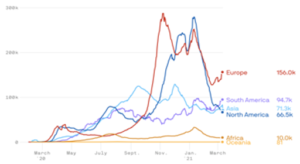One year in and the race towards herd immunity is on. But the pace of the race and who is currently out in front varies greatly across the globe. A great reset in terms of post COVID-19 social contracts is taking place in many parts of the world – with the US leading the way. What international travel will require and resemble in this new era is far from clear.
- Last week marked the one-year ‘official’ anniversary of COVID-19 pandemic, when the WHO officially declared so, three months after the virus was first identified in China. The chart below illustrates the 7-day average of daily reported COVID-19 cases by continent from 1 February 2020 to 11 March 2021.
Source: Our World in Data, Axios visuals
- At the moment, the COVID-world is divided into three broad groups: (1) countries that are successfully containing the pandemic with ’turbocharged’ vaccination campaigns (Israel, the US and the UK); (2) countries facing a resurgence of cases caused by vaccine rollouts moving much too slowly (continental Europe and much of Latin America); (3) countries with slow vaccination campaigns but with very few cases (most of Asia and Oceania).
- Herd immunity is not a binary notion (we have it or we don’t). The more people have been infected and the higher the rate of vaccination, the higher the level of natural immunity. Take the example of the US: almost 20% of the population has received at least one vaccine shot and nearly 30% of Americans have had the virus, suggesting that about 40% of Americans are protected against COVID (there is some overlap between the two groups). The pandemic is far from being over, but the virus has a much smaller pool of people it can infect. The more natural immunity rises (through vaccinations or infection), the faster transmission slows down. The pace of immunization is the most critical variable in vanquishing the pandemic.
- With the pandemic receding globally and the on-going vaccination campaigns, vaccine passports are becoming a possible solution to renewed travel and mass gatherings. They’ll be introduced because it makes eminent sense and the technology allows it, but more slowly and in a more complicated fashion than we think. The reasons are the following: (1) from a scientific perspective, new variants may render some vaccines less efficient; (2) from an operational point of view, there are no unified standards yet; (3) there is an ethical hurdle: how to deal with the billions of people unable or unwilling to be vaccinated? Expect restrictions on international travel to endure.
- In COVID-19: The Great Reset that we wrote a year ago, we predicted that the pandemic would “change everything”. Nothing epitomizes better the scope and breadth of some of these changes than the US $1.9tr stimulus bill. America is reintroducing welfare, but all over the world governments have started to redraw the contours of their social contracts. Last year, more than 1,600 new social protection programmes were launched in countries across the globe.



